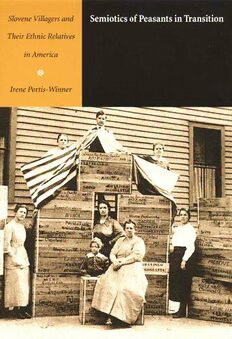
Semiotics of Peasants in Transition: Slovene Villagers and Their Ethnic Relatives in America PDF
Preview Semiotics of Peasants in Transition: Slovene Villagers and Their Ethnic Relatives in America
Semiotics of Peasants in Transition Sound and Meaning The Roman Jakobson Series in Linguistics and Poetics C. H. van Schooneveld, Series Editor Irene Portis-Winner R Semiotics of Peasants in Transition Slovene Villagers and Their Ethnic Relatives in America Duke University Press Durham and London 2002 ∫ 2002 Duke University Press All rights reserved Printed in the United States of America on acid-free paper $ Designed by C. H. Westmoreland Typeset in Minion by Keystone Typesetting, Inc. Library of Congress Cataloging-in-Publication Data appear on the last printed page of this book. To Benjamin and Kyla with love Contents Acknowledgments ix I The Dynamics of a Dialogic Relation between a Peasant Village and Its Ethnic Counterpart: A Semiotic Approach Prologue: ‘‘The Strange Intruder’’ (from Peirce): A Peasant Village and Its Many Others 3 1. A Glance at the Village and Its Sister Ethnic Communities in Cleveland and Hibbing 11 II Theoretical Issues and Terminology: From the Outer to the Inner Point of View 2. Nationalism, Ethnic Identity, Transnationalism: Issues of Terminology 31 3. Can We Find the Inner Point of View? Interpretative Anthropology, Performance Anthropology 43 4. Semiotics of Culture 50 III The Village and the Slovene Communities in Cleveland and Hibbing: A Historical Perspective 5. Zˇerovnica: Its Past and the Question of the Future 77 6. The Story of the Ethnic Community in Cleveland 106 IV Semiotic Portraits 7. Semiotic Portraits in Cultural Context 127 8. Concluding Remarks 152 Notes 157 Selected Bibliography 161 Index 181 Acknowledgments I wish to thank the following foundations and individuals who supported this study: the International Research and Exchanges Committee (IREX) in 1992 provided a grant in aid for travel to Zˇerovnica, and in 1995 it supported my travel to the Czech Republic to present some of my findings at a con- ference on Jakobson. The Joint Committee on Eastern Europe of the Ameri- can Council of Learned Societies provided grants in 1973 for work in Zˇerov- nica, in 1975–76 for work among Zˇerovnicans in Cleveland and Minnesota, and in 1977 for the research and writing of a position paper on the semiotics of culture. A USIA grant provided funds for presenting some of my theoret- ical work at the Masaryk University in Brno, Czech Republic; and a grant from the Immigration History Archives of the University of Minnesota provided a grant for the use of their archival materials, opening these holdings to me most generously. All these grants are gratefully acknowl- edged. My last stay in Slovenia in 1995 was partly financed by the Scientific Research Center (Znanstveni in raziskovalni center) of the Slovene Academy of Sciences and the Arts (SAZU). Its Director, Dr. Oto Luthar, invited me to present a paper on my project at the Slovene Academy of Sciences and Arts. In Zˇerovnica and its sister village Grahovo, many helped. We must let a listing of a few su≈ce. In 1964–65 the late Marija (Micka) Mertelj provided space in her house in Grahovo for our family, my husband and two (then) teenage daughters. And her son Marijan, now deceased, and his wife, Ma- rija, and their daughter, Meta Polovicˇ, continued this hospitality. In Zˇerov- nica proper, my heartfelt thanks go out to the family of the late Matija and Marija Rok. Matija Rok had been the village headman of Zˇerovnica until the Communist administration deprived the village of its autonomy. He still held much of the village documentation such as maps and deeds in his possession, and he was a welcome fount of information and wisdom. Both Matija and Marija Rok became close friends, and their hospitality knew no bounds. The same can be said of the next generation of the family, the Roks’ daughter Marija, now deceased, her husband Anton (Tone) Primozˇicˇ, and their daughters, Marija and Antonia (Toncˇka), both of whose births and first birthdays we celebrated in Zˇerovnica in the 1960s. Much help was also received from the various priests in the Grahovo parish that includes Zˇerov-
